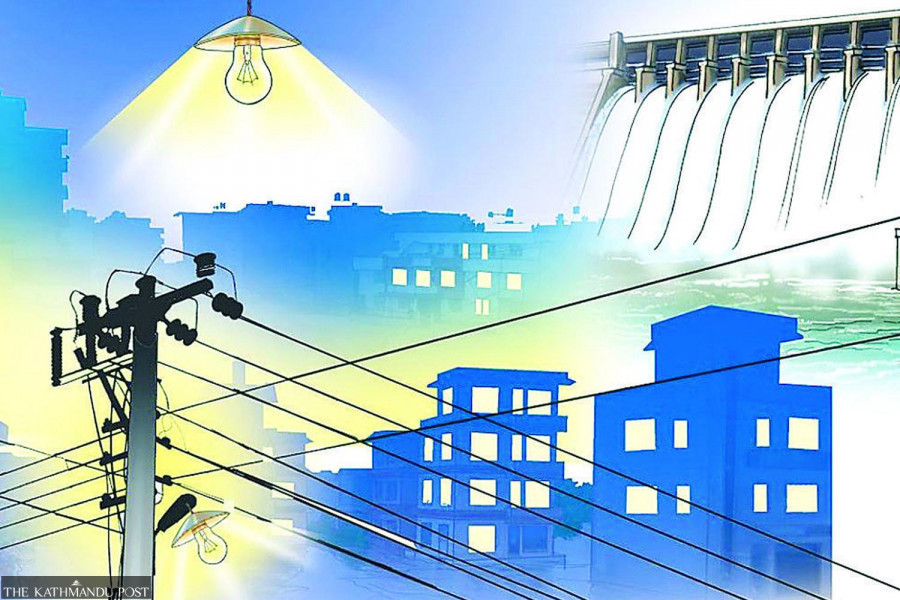Opinion
Cost of electricity exports
Power exports may not benefit Nepalis despite earning billions in revenue.
Bishal Thapa
Nepal has always maintained that hydropower electricity exports will lead to economic growth and development for its people. This narrative intensified after the end of load-shedding (forced blackouts from supply shortages) in 2017, as reports suggested that electricity generation would exceed domestic demand. Authorities routinely warned of major economic losses if the excess generation did not find an export market in India or from there to other countries in the region.
This narrative has become so all-consuming that Nepal’s leadership is now measured in megawatts (MW). Foreign Minister Arzu Rana Deuba is currently at 251 MW after she secured India’s agreement to purchase additional power from 12 hydro plants during her visit to India in August 2024.
Energy Minister Dipak Khadka is at 40 MW after he symbolically inaugurated Nepal’s export to Bangladesh via India on November 16, 2024, as part of an agreement where Nepal will annually export 144 million units (GWh) over five months between June and November. Kulman Ghising, Managing Director of the Nepal Electricity Authority (NEA), is at 941 MW because India’s current commitment to purchase up to this level has come under his watch.
Nepal’s relentless focus on exporting electricity achieved a major milestone this year. For the first time, Nepal became a net exporter of electricity in the last fiscal year (2023-24), earning Rs137 million more from exports than imports. Over 2023-24, the NEA imported 1,845 million units (GWh) and exported 1,946 GWh, earning Rs17.1 billion from exports while paying Rs16.9 billion for imports, its annual report for 2023-24 states.
Nepal now earns billions from exporting electricity. But the outsized national emphasis on electricity exports perpetuates Nepal’s energy poverty, distracts from a balanced approach to development and will ultimately not benefit the people of Nepal.
Underestimated domestic demand
“We have been exporting excess electricity left over after daily consumption in the domestic market,” Ghising said in August 2024, when announcing that Nepal had become a net electricity exporter.
Ghising is not telling the truth. Nepal exports electricity without adequately fulfilling the needs of its own people. Large segments of Nepalis, particularly the poor who would benefit the most, remain significantly underserved.
The NEA’s own data reveals that Nepal’s average monthly household electricity consumption was approximately 69 units (or kWh) in 2022-23. Consumption is highly uneven among households: Approximately 2.1 million (or 45 percent) of the 4.7 million households that have a metered grid connection consume approximately 7 kWh monthly on average per household. The remaining 2.6 million households consume approximately 119 kWh on average per household every month.
These levels of household electricity use are absurdly low, particularly because over 90 percent of Nepal has access to grid electricity and there is (reportedly) excess generation. Nepal’s income levels could support much higher electricity consumption levels if they were supplied with more electricity.
Ownership of household electric appliances is one way to estimate how much more electricity Nepali homes could use. The Nepal National Population and Housing Census 2021 revealed strong appliance ownership across households, with most owning at least one asset.
These levels of electric appliance ownership, if used as they should be, suggest that electricity consumption in households should be at least 5,602 GWh, or 40 percent higher than what the NEA supplied to households in 2022-23. The electricity authority arguing that it has met all electricity demand in Nepal is like saying Nepalis buy televisions, fridges, fans, air conditioners and other electric household appliances only to keep them switched off.
Another way to illustrate Nepalis being underserved is through comparisons of electricity use with other countries. A Nepali on average (or per-capita electricity consumption) currently uses approximately 380 kWh per year. This is again strikingly low for Nepal’s income, given the high level of electricity access and (supposed) excess generation.
Under the current pattern of electricity use, on average, a Nepali would consume only 55 percent of what an Indian would use, even if Nepal’s per-capita income were the same as that of India. Nepal’s per capita electricity consumption would be only 69 percent of Bangladesh, and 54 percent of Vietnam if Nepal’s income were normalised to that of Bangladesh and Vietnam, respectively.
Even with their current incomes, Nepalis would easily consume 40 percent to 50 percent more electricity if they were supplied that extra amount. They could absorb all the current electricity exports, if it were made available to them. Tragically, the NEA earns on average almost Rs1 more when selling domestically than it does when exporting.
Nepal’s electricity export strategy fails to provide Nepalis with the electricity they need and then charges them more per unit than for export. How can such a strategy ever benefit the people of Nepal?
Unbalanced development
The outsized national emphasis on electricity exports is undermining efforts in other important areas likely to benefit Nepalis much more significantly.
To put electricity exports in perspective, the total electricity exports in 2022-23 were Rs17 billion, constituting just 11 percent of Nepal’s total exports for that year. The trade balance on electricity (i.e., exports minus imports) was Rs137 million for 2022-23, an insignificant 6 percent of the trade balance of just one commodity group (coffee, tea, mate and spices) based on data from the customs department.
Within that category, cardamom is an example of how the outsized focus on electricity exports is detrimental to many Nepalis. In 2022-23, Nepal exported Rs8.2 billion of large cardamom, growing threefold over the last decade. Cardamom exports are now half the size of electricity exports and tens of times higher than the trade balance in electricity.
Cardamom shares many parallels with electricity. Restrictive policies of importing countries hamper their exports. For example, Bangladesh imposes a 90 percent tax on imports of Nepali cardamom. Almost half of Nepal’s cardamom exports to India are then traded to other South Asian countries via Dubai, significantly increasing their costs and losses and rendering them less competitive. The South Asia Free Trade Area or other agreements could address many of these trade barriers.
Nepal’s government has never meaningfully pursued any effort to facilitate cardamom exports to Bangladesh via India, much like they have secured the export of electricity to Bangladesh via India. Cardamom employs thousands of small farmers. Increased production and exports would enhance rural employment, particularly for women, and spur growth. Relative to electricity, cardamom exports would result in higher trade balance revenues and directly benefit many more people, particularly in rural areas.
Cardamom is just one commodity. There are many other products for which exports could be significantly expanded with sustained effort. In a 2021 report, Kene Ezemenari, Senior Economist with the World Bank, estimated “Nepal’s untapped export potential to be around $9.2 billion, 12 times its actual annual merchandise exports.”
Ezemenari found that realising this export potential could create 220,000 new jobs and increase productivity growth. It requires consistent investment and engagement with importing countries like Nepal has done for electricity.
Unfortunately, Nepal’s leadership has no time for initiatives outside electricity. They are blinded by and too busy counting the MWs contracted with India.
Nepal has 40,000 MW of hydro power potential. Most Nepalis will benefit from none of it.




 13.12°C Kathmandu
13.12°C Kathmandu











